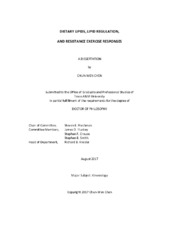| dc.contributor.advisor | Riechman, Steven E | |
| dc.creator | Chen, Chun Wen | |
| dc.date.accessioned | 2018-02-05T21:21:23Z | |
| dc.date.available | 2019-08-01T06:54:28Z | |
| dc.date.created | 2017-08 | |
| dc.date.issued | 2017-07-18 | |
| dc.date.submitted | August 2017 | |
| dc.identifier.uri | https://hdl.handle.net/1969.1/166043 | |
| dc.description.abstract | Being the largest tissue that accounts for 40-50% of overall metabolism in non-obese individuals, skeletal muscle is a modifiable target for reducing the risk of chronic diseases. Resistance exercise induces cell signaling pathways that promote muscle protein synthesis via muscle contraction, inflammation, and hormones. Lipids facilitate these mechanisms through the provision of energy and building blocks for cell regeneration, regulation of membrane permeability for hormones, and formation of lipid rafts for signaling molecules. Exercise increases free fatty acids and mobilizes several kinases, the factors that activate the skeletal muscle lipid regulator PPARδ. The purpose of this study was to test the hypotheses that dietary lipids would improve skeletal muscle adaptations to resistance exercise training and that resistance exercise would enhance lipid metabolism as demonstrated by the upregulation of PPARδ.
The first study examined the changes in skeletal muscle mass, strength, peak power, and quality in response to a 12-week whole-body progressive resistance exercise training (8 sets/12 reps, 70% 1RM) with different levels of dietary cholesterol supplementation. Secondary analyses included determination of the association between dietary fatty acids and skeletal muscle adaptation. No effects of dietary cholesterol on the training-induced muscle adaptation was observed. Exploratory analyses of dietary fatty acids suggested potential effects on adaptations. The second study explored the effects of dietary cholesterol and fatty acids on the muscle protein synthesis and soreness induced by a short-term high-intensity unilateral leg resistance exercise (5 set/reps until failure, 85% 1RM). Muscle protein synthesis rate was not significantly different between the exercised and non-exercised legs during the 22 hours after the exercise. In the high cholesterol intake group, muscle PPARδ protein content was 38.9±24.1% higher in the exercised than the non-exercised legs and soreness levels were 91.6±3.6% lower than the low cholesterol intake group. The third study investigated the effects of a 10-week whole-body progressive resistance exercise training (8 sets/12 reps, 75% 1RM) on muscle PPARδ protein content. Before the training, PPARδ protein content acutely increased by 49.1±0.29% after one bout of exercise and the increase was inversely proportional to body fat percentage. Resting muscle PPARδ protein content increased by 114.7±0.32% after the training.
The findings in these studies provided insights into the potential effects of lipids on skeletal muscle adaptation and the mechanism of lipid regulation induced by resistance exercise. | en |
| dc.format.mimetype | application/pdf | |
| dc.language.iso | en | |
| dc.subject | PPAR | en |
| dc.subject | PPARs | en |
| dc.subject | PPAR-delta | en |
| dc.subject | PPARd | en |
| dc.subject | PPARδ | en |
| dc.subject | PPAR-δ | en |
| dc.subject | resistance exercise | en |
| dc.subject | resistance training | en |
| dc.subject | resistance exercise training | en |
| dc.subject | physiology | en |
| dc.subject | exercise physiology | en |
| dc.subject | peroxisome proliferator activated receptor | en |
| dc.subject | peroxisome proliferator activated receptor delta | en |
| dc.subject | peroxisome proliferator activated receptor-delta | en |
| dc.subject | peroxisome proliferator activated receptor δ | en |
| dc.subject | peroxisome proliferator activated receptor-δ | en |
| dc.subject | weight training | en |
| dc.subject | exercise | en |
| dc.subject | lipid | en |
| dc.subject | lipids | en |
| dc.subject | fatty acid | en |
| dc.subject | fatty acids | en |
| dc.subject | cholesterol | en |
| dc.subject | LDL | en |
| dc.subject | HDL | en |
| dc.subject | dietary | en |
| dc.subject | skeletal muscle | en |
| dc.subject | muscle | en |
| dc.subject | nutrition | en |
| dc.subject | muscle | en |
| dc.subject | skeletal muscle | en |
| dc.subject | muscle biology | en |
| dc.subject | biology | en |
| dc.subject | lipid metabolism | en |
| dc.subject | fatty acid oxidation | en |
| dc.subject | lipid oxidation | en |
| dc.title | Dietary Lipids, Lipid Regulation, and Resistance Exercise Responses | en |
| dc.type | Thesis | en |
| thesis.degree.department | Health and Kinesiology | en |
| thesis.degree.discipline | Kinesiology | en |
| thesis.degree.grantor | Texas A & M University | en |
| thesis.degree.name | Doctor of Philosophy | en |
| thesis.degree.level | Doctoral | en |
| dc.contributor.committeeMember | Fluckey, James D | |
| dc.contributor.committeeMember | Crouse, Stephen F | |
| dc.contributor.committeeMember | Smith, Stephen B | |
| dc.type.material | text | en |
| dc.date.updated | 2018-02-05T21:21:24Z | |
| local.embargo.terms | 2019-08-01 | |
| local.etdauthor.orcid | 0000-0003-1818-4517 | |


